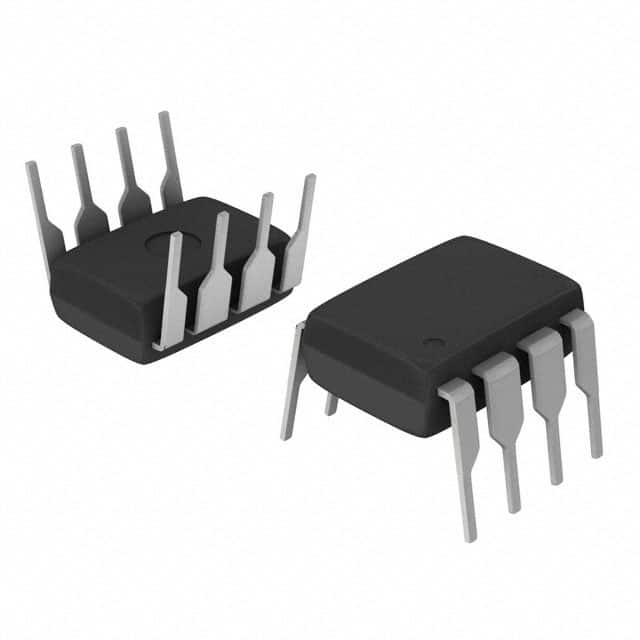Voir les spécifications pour les détails du produit.

MCP4161-103E/P
Introduction
The MCP4161-103E/P is a digital potentiometer belonging to the category of integrated circuits. It is commonly used in electronic circuits to provide variable resistance and is characterized by its compact package, precise control, and versatile applications.
Basic Information Overview
- Category: Integrated Circuits
- Use: Provides variable resistance in electronic circuits
- Characteristics: Compact, precise control, versatile
- Package: 8-pin PDIP/SOIC
- Essence: Digital potentiometer for circuit design
- Packaging/Quantity: Available in tape and reel packaging, quantity varies
Specifications
- Resistance Value: 10 kΩ
- Tolerance: ±20%
- Interface: SPI
- Operating Voltage: 2.7V to 5.5V
- Temperature Range: -40°C to +125°C
Detailed Pin Configuration
The MCP4161-103E/P features the following pin configuration: 1. VDD - Power supply input 2. CS - Chip select for SPI interface 3. SCK - Serial clock for SPI interface 4. SI - Serial data input for SPI interface 5. SO - Serial data output for SPI interface 6. A - Terminal A of the potentiometer 7. W - Wiper terminal of the potentiometer 8. B - Terminal B of the potentiometer
Functional Features
- Digital control for precise resistance adjustment
- Non-volatile memory for storing settings
- Low power consumption
- Wide operating voltage range
Advantages and Disadvantages
Advantages: - Precise and repeatable resistance settings - Compact size for space-constrained designs - Non-volatile memory eliminates the need for external storage
Disadvantages: - Limited maximum resistance value - Tolerance of ±20% may not be suitable for high-precision applications
Working Principles
The MCP4161-103E/P operates by digitally controlling the position of the wiper terminal within the potentiometer, effectively changing the resistance between terminals A and B. This digital control allows for precise and repeatable adjustments to the resistance value.
Detailed Application Field Plans
The MCP4161-103E/P finds extensive use in various electronic applications, including: - Audio equipment for volume control - Instrumentation for calibration and offset adjustment - Industrial control systems for parameter tuning - Automotive electronics for sensor calibration
Detailed and Complete Alternative Models
- MCP4161-104E/P - 100 kΩ resistance value
- MCP4161-102E/P - 1 kΩ resistance value
- MCP4161-503E/P - 50 kΩ resistance value
In conclusion, the MCP4161-103E/P digital potentiometer offers precise and versatile resistance control in a compact package, making it an ideal choice for a wide range of electronic applications.
Word count: 411
Énumérez 10 questions et réponses courantes liées à l'application de MCP4161-103E/P dans les solutions techniques
What is the MCP4161-103E/P?
The MCP4161-103E/P is a digital potentiometer, also known as a digital variable resistor, that can be used to digitally control resistance in electronic circuits.What is the typical application of MCP4161-103E/P?
The MCP4161-103E/P is commonly used in applications where precise and digitally controlled resistance adjustments are required, such as in audio equipment, instrumentation, and industrial control systems.What is the resistance range of MCP4161-103E/P?
The MCP4161-103E/P has a resistance range of 100 ohms to 10 kilohms.How is the MCP4161-103E/P controlled?
The MCP4161-103E/P can be controlled using a digital interface, such as SPI (Serial Peripheral Interface) or I2C (Inter-Integrated Circuit) communication protocols.Can the MCP4161-103E/P be used in automotive applications?
Yes, the MCP4161-103E/P is suitable for use in automotive applications, provided it meets the necessary environmental and performance requirements.What is the power supply voltage range for MCP4161-103E/P?
The MCP4161-103E/P operates within a wide power supply voltage range, typically from 2.7V to 5.5V.Is the MCP4161-103E/P available in different package types?
Yes, the MCP4161-103E/P is available in various package types, including PDIP, SOIC, and TSSOP.Can the MCP4161-103E/P be used in audio volume control applications?
Yes, the MCP4161-103E/P is commonly used in audio volume control applications due to its digital control and precise resistance adjustment capabilities.What is the temperature range for MCP4161-103E/P?
The MCP4161-103E/P is designed to operate within a wide temperature range, typically from -40°C to 125°C.Are there any specific layout considerations when using MCP4161-103E/P in a circuit?
Yes, it is important to follow the recommended layout guidelines provided in the MCP4161-103E/P datasheet to ensure proper performance and reliability in the circuit design.

